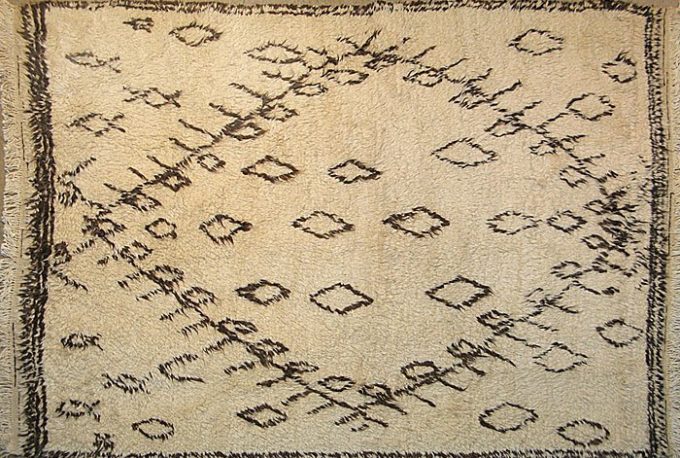When one thinks of interior design and artisanal craftsmanship, Beni Ourain rugs undoubtedly emerge as a timeless marvel. These rugs, originating from the mountainous region of Morocco, are not just decorative elements; they are woven narratives, steeped in history and tradition. Are you ready to embark on a colorful journey into the intricate world of Beni Ourain rug-making? Let’s explore the meticulous artistry and the fascinating process behind these exquisite pieces.
The Origins of the Beni Ourain
Before delving into the craftsmanship, it’s essential to understand where these magnificent artifacts come from. The Beni Ourain tribe, residing in the Atlas Mountains, has a legacy of weaving that dates back centuries, if not millennia. These artisans utilized wool from the region’s sheep, known for its warmth and durability. The Beni Ourain rugs are characterized by their geometric patterns and natural hues, often reflecting the natural surroundings of the Berber people. Each pattern tells a story, conveying cultural nuances and historical significance unique to the tribe.
Material Selection: The Foundation of Quality
The genesis of a Beni Ourain rug begins with wool selection. Artisans are selective when choosing the fibers, primarily utilizing the soft, lustrous wool from local sheep. The preferences lean towards sheep that thrive in the mountainous terrain, as their fleece is not only resilient but also provides the necessary warmth. But here’s the challenge: can you identify the difference between high-quality rug wool and inferior wool? One need only feel the texture; the former should be incredibly soft yet sturdily resilient. Well-chosen wool leads to a constructed carpet that withstands the ravages of time while maintaining its aesthetic charm.
The Art of Dyeing: A Natural Palette
Once the desired wool is procured, the next step is dyeing. This is where playful creativity comes into play. Traditionally, vegetable dyes are employed to achieve stunning colors. Natural sources such as indigo (for blue), saffron (for yellow), and madder root (for red) manifest vibrant hues. Yet, synthetic dyes have crept into the realm of rug-making, presenting a provocative question: is the vibrancy of modern synthetics worth sacrificing the connection to tradition? Consider the look and feel of your home—would you rather have a vivid hue that lacks heritage or a muted natural color brimming with story? The choice is yours.
Design: Geometry Meets Symbolism
As you transition from dyeing to design, the challenge continues. What does each pattern represent? Each Beni Ourain rug boasts intricate geometric designs, often inspired by nature and the community’s daily life. Abstract shapes symbolize fertility, protection, and even the journey of life. Artisans, primarily women, draw from their cultural ethos, translating their surroundings into visually stunning motifs. Feel free to ponder: how does your favorite geometric shape resonate with your taste? Is it the precision of symmetry or the charm of imperfection that you find most appealing?
The Weaving Process: An Intimate Artistry
Now, the moment of truth arrives: the weaving. This process is an intimate dance between the artisan and their loom. Using a simple hand loom, an artisan weaves the dyed wool into a tapestry of expressions. The tightness of the weave determines the rug’s texture and durability, requiring both skill and patience. As you imagine this scene, consider: how long do you think it takes to weave a standard rug? Some can take weeks, while larger pieces may require months of dedicated effort. As the strands intertwine, they create a bonded narrative, really a labor of love.
Finishing Touches: Craftsmanship Revelations
Completing the masterpiece involves meticulous attention to detail. Once the weaving is done, the rug undergoes a shearing process. This is not merely to trim the threads, but also to enhance texture and appearance. The artisan ensures that each piece is uniform while keeping the unique character of the rug intact. A final wash ensures cleanliness and brings the colors to life. Here’s a revealing challenge: dive into your home décor. Can you spot the nuances in your textile choices? The subtle differences can speak volumes about the origins and efforts behind them.
The Journey Continues: From Creation to Home
Once the rugs are finished, they embark on a journey to their new homes. Many of these intricate creations are sold at local markets or exported globally, introducing the beauty of Moroccan craftsmanship to diverse cultures. A Beni Ourain rug brightens up a space, transforming an ordinary room into a tapestry of tales.
Preserving the Craft: A Future Worth Cherishing
As modernity strides forward, the question arises: how do we preserve such an age-old tradition? Encouraging artisans through fair trade practices and recognizing the cultural value of their creations is crucial. Support local artists, and you are not merely purchasing a rug; you are becoming part of a lineage, a continuation of tradition.
The luxurious Beni Ourain rugs embody a convergence of history, artistry, and symbolism. Each piece is a woven dialogue, waiting to engage with those who adorn their homes with these stunning works of art. As you navigate the world of interior design, keep in mind the layered significance behind these rugs. They are not mere decorative items; they are connections to a rich and vibrant culture, deserving of appreciation and respect in every fiber. So, what will your next decor choice be? Will it be a fleeting trend, or will you opt for a timeless piece that tells its story every time you step onto it?

